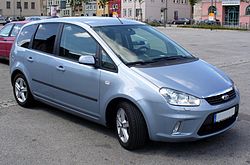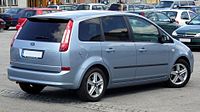Ford C-Max: Difference between revisions
Mk II |
|||
| Line 27: | Line 27: | ||
{{Distinguish|Ford S-Max}} |
{{Distinguish|Ford S-Max}} |
||
The '''Ford C-Max''' is a [[compact MPV]] produced by Ford in [[Saarlouis]]<ref>[http://media.ford.com/article_display.cfm?article_id=25711 New Ford C-Max production begins in Saarlouis, Germany]</ref> for the [[Europe]]an market since 2003. |
The '''Ford C-Max''' is a [[compact MPV]] produced by Ford in [[Saarlouis]]<ref>[http://media.ford.com/article_display.cfm?article_id=25711 New Ford C-Max production begins in Saarlouis, Germany]</ref> for the [[Europe]]an market since 2003. |
||
==Background== |
|||
With the introduction of the new [[large MPV]]s [[Ford S-Max|S-Max]] and [[Ford Galaxy|Galaxy]], the C-Max is the smallest [[multi-purpose vehicle]] of Ford's lineup. |
|||
==Mk I - Ford Focus C-Max== |
|||
[[Image:Ford C-MAX 1.jpg|left|200px]] |
[[Image:Ford C-MAX 1.jpg|left|200px]] |
||
C-Max Mk I was the first product to use the [[Ford C1 platform]], also used by the [[Ford Focus (International)|Ford Focus Mk II]] and the compact MPV [[Mazda Premacy|Premacy/Mazda5]]. Its internal code name is C214. |
|||
| ⚫ | |||
| ⚫ | |||
It seats five passengers and has a large amount of cargo space, which can be increased by folding the rear seats flat. Some models feature diagonally sliding outer rear seats. It also shares the control blade independent rear suspension from the Focus. |
It seats five passengers and has a large amount of cargo space, which can be increased by folding the rear seats flat. Some models feature diagonally sliding outer rear seats. It also shares the control blade independent rear suspension from the Focus. |
||
===Facelift=== |
|||
| ⚫ | |||
| ⚫ | <ref>[http://media.ford.com/newsroom/release_display.cfm?release=24947 Ford Motor Company - Press Release - Ford Previews New C-Max At Bologna Motor Show]</ref> The pre-facelift version of the car (2003-2007) was called the Ford Focus C-Max. The name change to C-Max is attributable to Ford's MPV strategy of creating a 'Max' branded line of MPVs, starting with the [[Ford S-Max]], launched in 2006. |
||
| ⚫ | The facelift brought the car in line with Ford's 'Kinetic Design' design language, evidenced through its twin trapezoidal grilles, large wheel arches and angular headlights. However, as the car does not have a bodyshell originally designed for 'Kinetic Design,' Ford officially states that the car contains only 'elements' of the design language. |
||
[[Image:Focus_cmax.jpg|left|thumb|175px|UK specification pre-facelift (2003) Focus C-Max]] |
[[Image:Focus_cmax.jpg|left|thumb|175px|UK specification pre-facelift (2003) Focus C-Max]] |
||
The available engines are the same as the Focus — the petrol versions are the 1.6 L, 1.8 L and 2.0 L aluminium [[Ford Duratec engine|Duratec]], and the 1.8 L Duratec Flexifuel, which runs on E85 [[bioethanol]] or petrol, while the diesel engines are the [[PSA Peugeot Citroën|PSA]]-developed [[Ford Duratorq engine|Duratorq]] 66 [[Watt|kW]] (90 [[Horsepower|hp]]) and 85 kW (109 hp) 1.6 (1560cc) L, Ford's own Lynx Duratorq 1.8 L 85 kW (115 hp), and the PSA-designed 100 kW (136 hp) 2.0 L. |
The available engines are the same as the Focus — the petrol versions are the 1.6 L, 1.8 L and 2.0 L aluminium [[Ford Duratec engine|Duratec]], and the 1.8 L Duratec Flexifuel, which runs on E85 [[bioethanol]] or petrol, while the diesel engines are the [[PSA Peugeot Citroën|PSA]]-developed [[Ford Duratorq engine|Duratorq]] 66 [[Watt|kW]] (90 [[Horsepower|hp]]) and 85 kW (109 hp) 1.6 (1560cc) L, Ford's own Lynx Duratorq 1.8 L 85 kW (115 hp), and the PSA-designed 100 kW (136 hp) 2.0 L. |
||
| Line 39: | Line 48: | ||
In the [[United Kingdom]], the car is available in Studio, Style, Zetec and Titanium trim levels. |
In the [[United Kingdom]], the car is available in Studio, Style, Zetec and Titanium trim levels. |
||
==Mk II== |
|||
| ⚫ | |||
C-Max is to be replaced in Europe in 2010, with a Mk II variant. Designed alongside the new [[Ford Focus]] Mk III, both will again be based on the same chassis. Look and theme will be coming from the [[Ford_Iosis#Iosis_MAX|Iosis Max]] concept, previewed at the 2009 Geneva Motor Show, with C-Max having a seven-seat variant.<ref>{{citeweb|url=http://www.autoexpress.co.uk/news/autoexpressnews/234878/new_focus_on_horizon.html|title=New Focus on horizon|publisher=autoexpress.co.uk|date=2009-03-30|accessdate=2009-07-18}}</ref> The booted variant is designed specifically for North-American market, supposedly coming to use between 2010 and 2012, and thus gradually replacing the [[Ford Focus (North America)#Second generation (2008-2010)|current Focus generation]].<ref>{{cite news |
|||
|url=http://www.autovore.com/2009/04/ford-focus-2010-nouvelle-infos/ |
|||
==Outside Europe== |
|||
|title=Ford Focus 2010: New Infos |
|||
The Ford C-Max is available in New Zealand but strangely it is not shown on www.ford.co.nz. |
|||
|date=2009-04-07 |
|||
|accessdate=2009-06-04 |
|||
|publisher=autovore.com |
|||
}}</ref> To be co-launched with the Focus, Focus will be built at Ford’s plant in Saarlouis, Germany; while C-Max production will move to [[Valencia]], [[Spain]], to allow lower production costs. |
|||
==References== |
==References== |
||
Revision as of 14:57, 19 July 2009
| Ford C-Max | |
|---|---|
 | |
| Overview | |
| Manufacturer | Ford Motor Company |
| Production | 2003—present |
| Assembly | Saarlouis, Germany |
| Body and chassis | |
| Class | Compact MPV |
| Body style | 5-door MPV |
| Layout | FF layout |
| Platform | Ford C1 platform |
| Related | Ford Focus Mazda Premacy |
| Powertrain | |
| Engine | 1.6L Duratec 1.8L Duratec 2.0L Duratec 1.6 TDCi 1.8 TDCi 2.0 TDCi |
| Transmission | 4-speed automatic 5-speed manual 6-speed manual CVT |
| Dimensions | |
| Wheelbase | Template:Auto mm |
| Length | Template:Auto mm |
| Width | Template:Auto mm |
| Height | Template:Auto mm |
The Ford C-Max is a compact MPV produced by Ford in Saarlouis[1] for the European market since 2003.
Background
With the introduction of the new large MPVs S-Max and Galaxy, the C-Max is the smallest multi-purpose vehicle of Ford's lineup.
Mk I - Ford Focus C-Max

C-Max Mk I was the first product to use the Ford C1 platform, also used by the Ford Focus Mk II and the compact MPV Premacy/Mazda5. Its internal code name is C214.
It seats five passengers and has a large amount of cargo space, which can be increased by folding the rear seats flat. Some models feature diagonally sliding outer rear seats. It also shares the control blade independent rear suspension from the Focus.
Facelift
In December 2006, the facelifted version of the C-Max was revealed at the 2006 Bologna Motor Show and went on sale in late spring 2007. [2] The pre-facelift version of the car (2003-2007) was called the Ford Focus C-Max. The name change to C-Max is attributable to Ford's MPV strategy of creating a 'Max' branded line of MPVs, starting with the Ford S-Max, launched in 2006.
The facelift brought the car in line with Ford's 'Kinetic Design' design language, evidenced through its twin trapezoidal grilles, large wheel arches and angular headlights. However, as the car does not have a bodyshell originally designed for 'Kinetic Design,' Ford officially states that the car contains only 'elements' of the design language.

The available engines are the same as the Focus — the petrol versions are the 1.6 L, 1.8 L and 2.0 L aluminium Duratec, and the 1.8 L Duratec Flexifuel, which runs on E85 bioethanol or petrol, while the diesel engines are the PSA-developed Duratorq 66 kW (90 hp) and 85 kW (109 hp) 1.6 (1560cc) L, Ford's own Lynx Duratorq 1.8 L 85 kW (115 hp), and the PSA-designed 100 kW (136 hp) 2.0 L.
In the United Kingdom, the car is available in Studio, Style, Zetec and Titanium trim levels.
Mk II
C-Max is to be replaced in Europe in 2010, with a Mk II variant. Designed alongside the new Ford Focus Mk III, both will again be based on the same chassis. Look and theme will be coming from the Iosis Max concept, previewed at the 2009 Geneva Motor Show, with C-Max having a seven-seat variant.[3] The booted variant is designed specifically for North-American market, supposedly coming to use between 2010 and 2012, and thus gradually replacing the current Focus generation.[4] To be co-launched with the Focus, Focus will be built at Ford’s plant in Saarlouis, Germany; while C-Max production will move to Valencia, Spain, to allow lower production costs.
References
- ^ New Ford C-Max production begins in Saarlouis, Germany
- ^ Ford Motor Company - Press Release - Ford Previews New C-Max At Bologna Motor Show
- ^ "New Focus on horizon". autoexpress.co.uk. 2009-03-30. Retrieved 2009-07-18.
- ^ "Ford Focus 2010: New Infos". autovore.com. 2009-04-07. Retrieved 2009-06-04.
